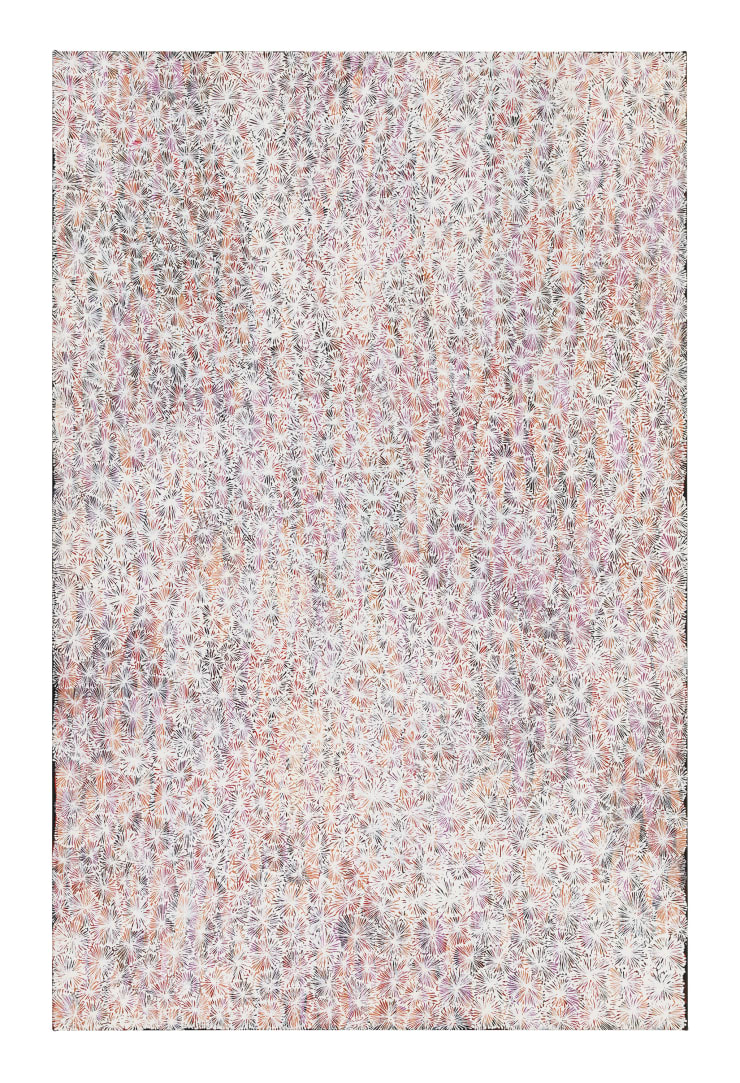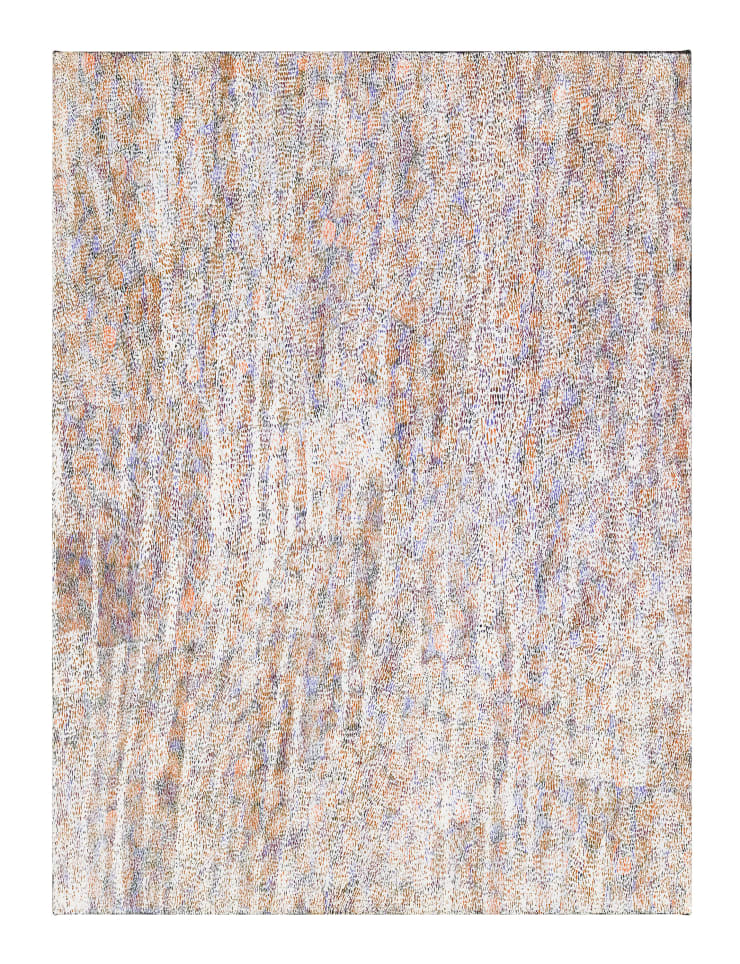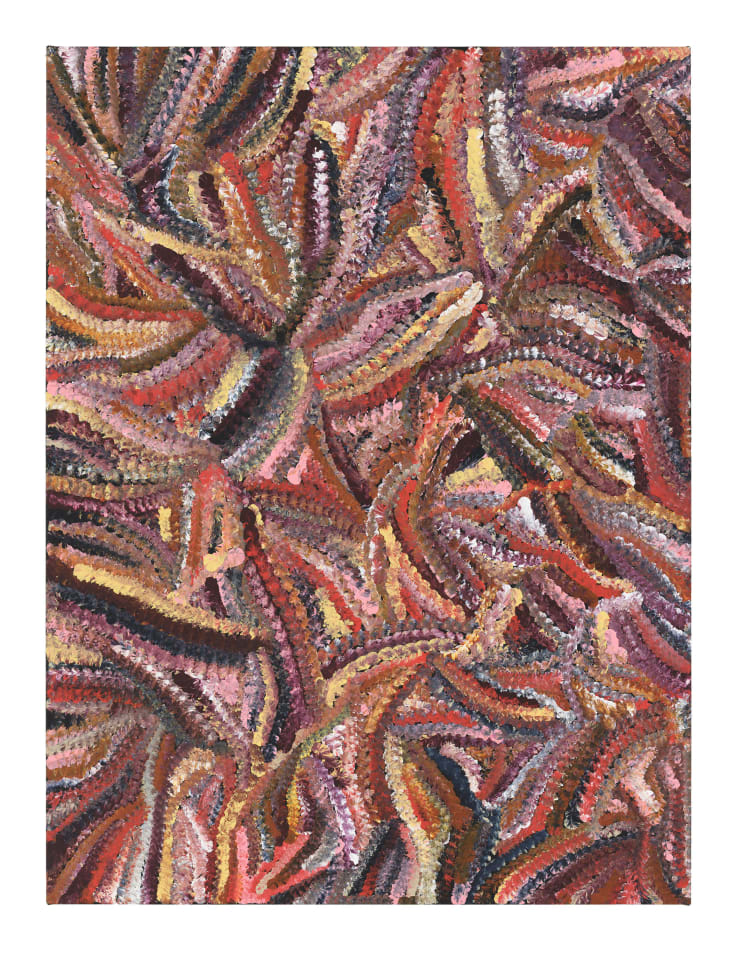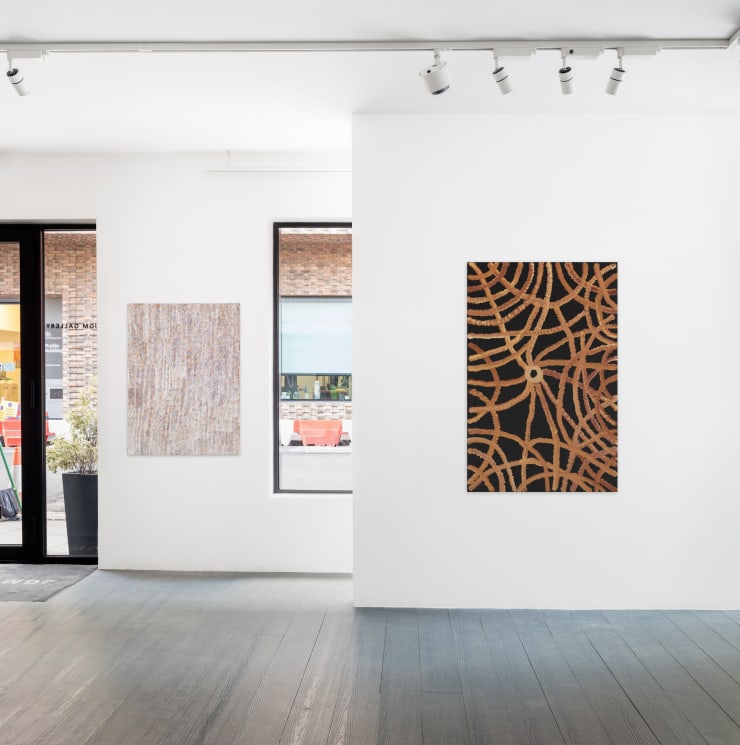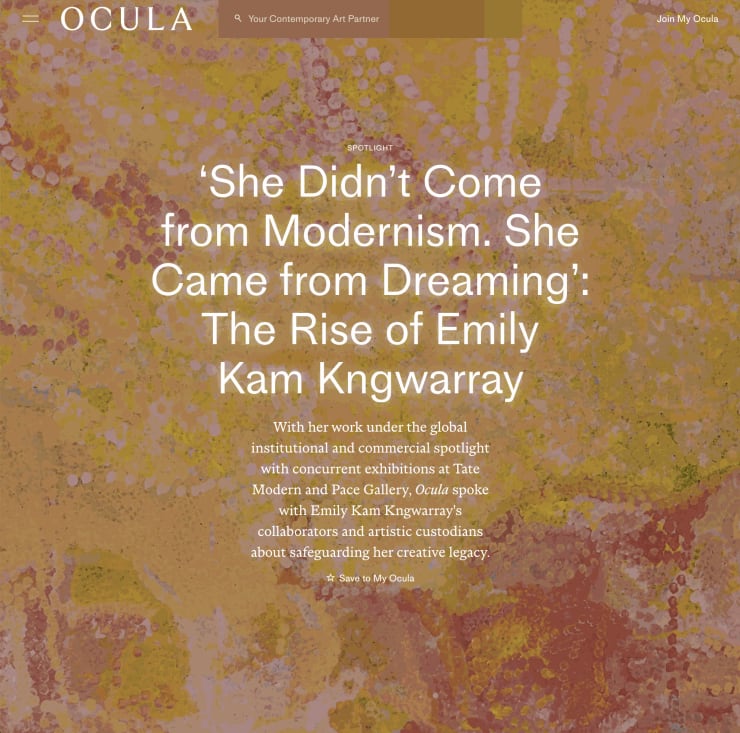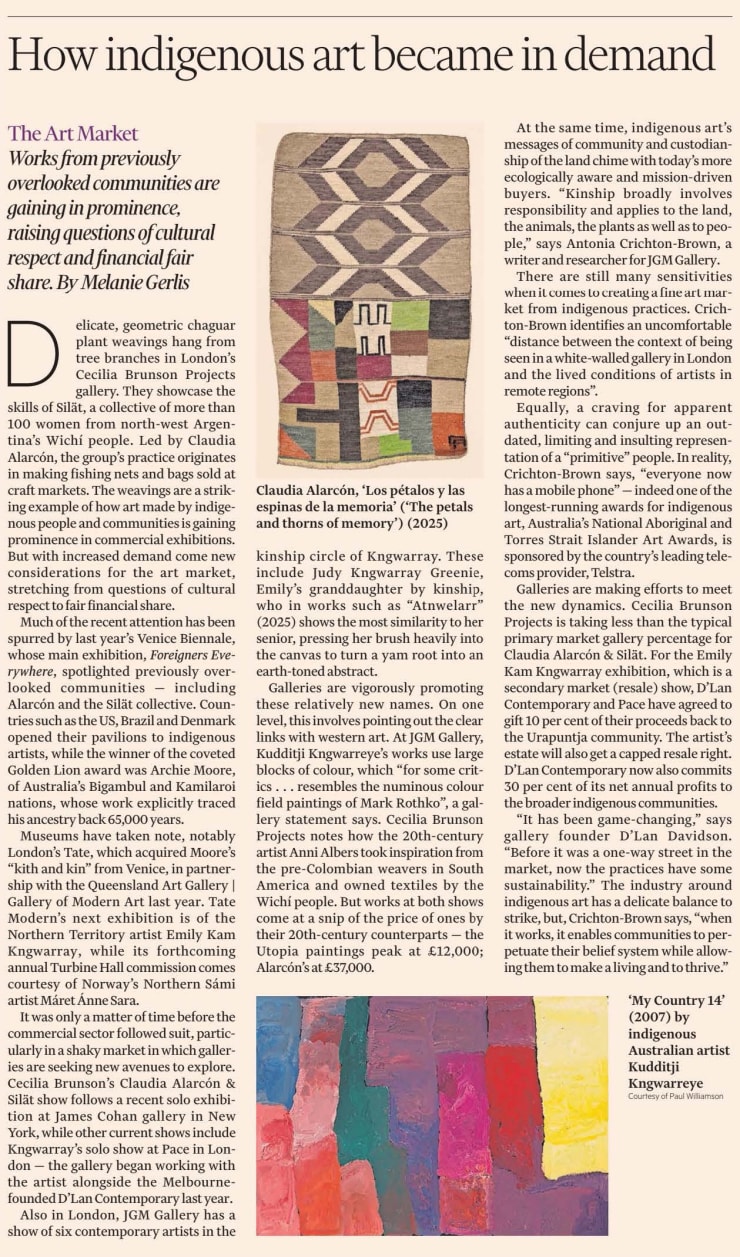We call it Urapuntja: An exhibition of paintings by six Indigenous contemporary artists.
“By showcasing these works by significant artists from Urapuntja, JGM Gallery hopes to emphasise the communal aspect of many artistic movements. Great art is rarely made in a vacuum, but is part of an ecosystem, born from generations of cultural maintenance, the passing down of skills and the sharing of stories.”
- Jennifer Guerrini Maraldi
JGM Gallery presents We call it Urapuntja, an exhibition of paintings by six Anmatyerr and Alyawarr contemporary artists from Urapuntja, Northern Territory, Australia.
The Urapuntja community gained international repute in the 1980s from the success of the late Emily Kam Kngwarray, a senior Anmatyerr woman and one of Australia’s most visionary contemporary artists. Urapuntja is on the border of Anmatyerr and Alyawarr homelands, making it a meeting ground for members of both language groups. Commonly known to English-speakers by early settler-pastoralists’ name for the area, Utopia, this community remains to this day a hub for evolving and dynamic artistic production, which is inevitably influenced by Kngwarray’s practice and the sensational impression she left on the contemporary art world.
The flourishing artistic climate of contemporary Urapuntja takes its momentum from the exceptional batik work made by members of the Utopia Women’s Batik Group in the late 1970s and 80s, and their acrylic paintings produced during ‘The Summer Project 1988/89’. Five of We call it Urapuntja’s exhibiting artists were involved in these landmark initiatives, either as artists or their younger assistants, who watched and mixed colours. These artists’ practices have continued to mature since those embryonic stages, with Josie Petyarr Kunoth’s work in particular transitioning from figurative representation into greater abstraction.
Western histories of art have often canonised individual artists at the cost of marginalising the wider cultural, historical and social contexts of their period and place of work. In the field of Indigenous contemporary art, this framework can diminish conversations that connect artworks to “Indigenous regimes of value” (Fred Myers, 2013), to which concepts of relationality, community and exchange are crucial. We call it Urapuntja runs concurrent to the first major retrospective dedicated to Emily Kam Kngwarray’s work in the United Kingdom at Tate Modern (10 July 2025 – 11 January 2026), emphasising her work’s place among that of her contemporaries, its relationship to their Countries and Altyerr/Angnekerr (Dreamings), and connections to those who continue to be influenced today by her considerable legacy.
The exhibiting artists all have some degree of connection to Emily, whether by nature of their family ties, sharing the same Altyerr/Angnekerr or Country (Alhalker), painting with her, being taught by her or influenced by her artistic style. Judy Kngwarray Greenie, for example, is Emily’s granddaughter by kinship and remembers “sitting down and helping [her]… with mixing up painting, brushes, kwatja (water) and sometimes cups of tea” as a child. Judy’s heavily marked streams of lines and layering compares to the depictions Emily made of her Yam Dreaming in the final years of her life. This resonance not only conveys the ongoing impact of Emily’s practice on Urapuntja’s contemporary artists, but a broader Anmatyerr identity, both expressed and documented through art.
We call it Urapuntja contrasts ten paintings by five women artists working from Utopia Art Centre with three major works by Kudditji Kngwarreye (b. 1938, d. 2017), who was a brother to Emily by kinship. This suite of Kudditji’s works comprise a solo presentation to both accompany We call it Urapuntja and communicate the distinctions between men’s and women’s stories from the Urapuntja homelands. Rather than veil-like, fluid and ebullient, in Kudditji’s paintings there is a sense of formula and organisation. For some critics, his iconography of large, adjacent colour blocks resembles the numinous colour field paintings of Mark Rothko. Kudditji’s works are, however, perhaps better understood beyond a purely formalist framework, as reflections of his persistent relationship to his Country around Boundary Bore and his Ankerr (Emu) Dreaming.
We call it Urapuntja focuses on the artistic community of Urapuntja, serving to expand on existing knowledge of its artists, their lands, important stories, styles and identities. As JGM Gallery Director, Jennifer Guerrini Maraldi, says, “By showcasing these works by significant artists from Urapuntja, JGM Gallery hopes to emphasise the communal aspect of many artistic movements. Great art is rarely made in a vacuum, but is part of an ecosystem, born from generations of cultural maintenance, the passing down of skills and the sharing of stories.”
Exhibiting artists: Josie Petyarr Kunoth · Audrey Kngwarreye Morton · Lucky Kngwarreye Morton · Judy Kngwarray Greenie · Jedda Kngwarray Purvis · Kudditji Kngwarreye.
-
 Lucky Kngwarreye MortonIlyarnayt, 2024Acrylic on linen102cm x 76cm
Lucky Kngwarreye MortonIlyarnayt, 2024Acrylic on linen102cm x 76cm -
 Lucky Kngwarreye MortonIlyarnayt, 2024Acrylic on linen138cm x 90cm
Lucky Kngwarreye MortonIlyarnayt, 2024Acrylic on linen138cm x 90cm -
 Audrey Kngwarreye MortonIlyarnayt, 2024Acrylic on linen102cm x 76cm
Audrey Kngwarreye MortonIlyarnayt, 2024Acrylic on linen102cm x 76cm -
 Audrey Kngwarreye MortonIlyarnayt, 2024Acrylic on linen138cm x 90cm
Audrey Kngwarreye MortonIlyarnayt, 2024Acrylic on linen138cm x 90cm -
 Jedda Kngwarray PurvisAtnwelarr, 2024Acrylic on linen102cm x 76cm
Jedda Kngwarray PurvisAtnwelarr, 2024Acrylic on linen102cm x 76cm -
 Jedda Kngwarray PurvisAtnwelarr, 2025Acrylic on linen102cm x 76cm
Jedda Kngwarray PurvisAtnwelarr, 2025Acrylic on linen102cm x 76cm -
 Josie Petyarr KunothAtnwelarr, 2025Acrylic on linen137cm x 89cm
Josie Petyarr KunothAtnwelarr, 2025Acrylic on linen137cm x 89cm -
 Josie Petyarr KunothAtnwelarr, 2023Acrylic on linen102cm x 76cm
Josie Petyarr KunothAtnwelarr, 2023Acrylic on linen102cm x 76cm -
 Judy Kngwarray GreenieAtnwelarr, 2025Acrylic on linen102cm x 76cm
Judy Kngwarray GreenieAtnwelarr, 2025Acrylic on linen102cm x 76cm -
 Judy Kngwarray GreenieAtnwelarr, 2025Acrylic on linen102cm x 76cm
Judy Kngwarray GreenieAtnwelarr, 2025Acrylic on linen102cm x 76cm -
 Kudditji KngwarreyeMy Country 24, 2009Acrylic on canvas91cm x 152cm
Kudditji KngwarreyeMy Country 24, 2009Acrylic on canvas91cm x 152cm -
 Kudditji KngwarreyeMy Country 20, 2008Acrylic on linen122cm x 121cm
Kudditji KngwarreyeMy Country 20, 2008Acrylic on linen122cm x 121cm -
 Kudditji KngwarreyeMy Country 14, 2007Acrylic on canvas125cm x 180cm
Kudditji KngwarreyeMy Country 14, 2007Acrylic on canvas125cm x 180cm


